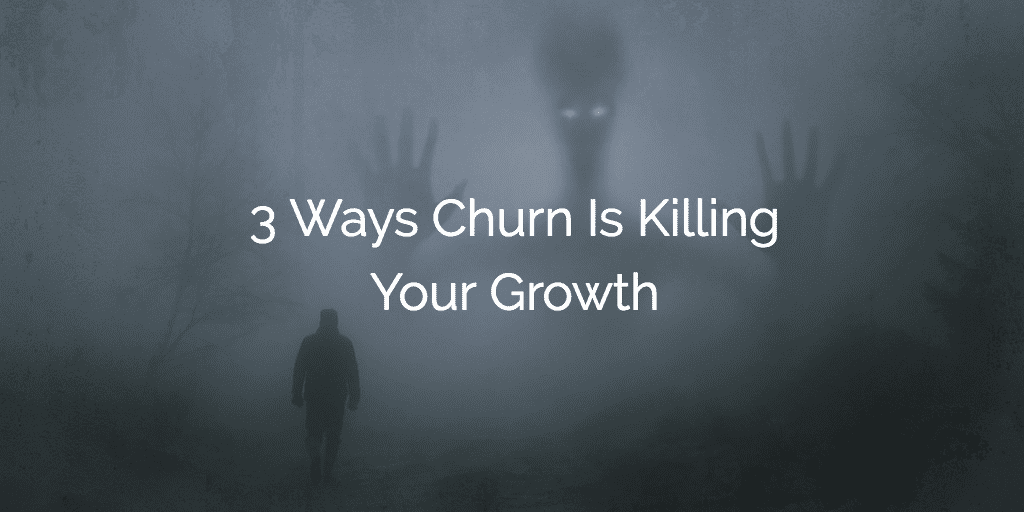It’s a dark, stormy night. You’re sitting at your computer. The lights flicker as you click open your reports and there you see it; the silent killer. Churn.

Churn is what folks in the subscription economy community call the percentage of customers that leave after subscribing to your product. Churn is one of the most important metrics in a recurring revenue business. These types of businesses rely on customers renewing and expanding their contracts, so closely following churn can be a huge indicator of company health. Below is a simple way to calculate churn based on customers. For more on calculating churn, check out our Essential Guide to Churn.
(Number of Customers Lost) ÷ (Original Number of Customers)
In classic slasher films, the characters always seem to ignore the little signs of danger. That bump in the night? Probably just the wind. Dogs barking? They always do that. Then all of a sudden—BAM! Freddy Krueger or Jason or Michael Myers is on them like a kid on Halloween candy. Churn can seem like an innocuous part of running a business. You’re bound to lose some customers, right? But, neglect your churn rate for too long and it might be the last thing you do …
#1: Churn is turning all your acquisition dollars into dust
When SaaS companies are starting out, it’s typical to pour revenue into customer acquisition. It makes sense, the more customers you sign on, the more your numbers go up,up, up. However, it can all come crashing down, down, down if you don’t have a solid retention strategy in place. A recurring revenue model relies on customers renewing at the end of their contract period and if all goes well, expanding into different products and verticals. If they reach the end of their contract and have not had a good experience thus far, they’ll take their money and promise of upsell/cross-sell with them.
We live in the Age of the Customer. The market is saturated with products and it’s given consumers the upper hand. Layer in the concept of the subscription and customers have an endless buffet of options they can try, with no long-term commitment. If you neglect customers during their journey with your product, there’s no guarantee that they will stay with you once their contract ends. Sure, there’s a cost that comes with ripping and replacing, but it’s nowhere near what it used to be in the days of legacy solutions.
Depending on how long your contracts are, you may not realize you have a problem with your customer journey until it’s too late. Mitigate churn risks by paying close attention to your customers’ desired outcomes before and during their use with your product. It can cost seven times more to acquire new customers than to retain current ones. That means for every customer you allow to churn, you’re not just sacrificing the potential revenue they could bring in, but also the money you already invested to get them as customers. Focus on clearly demonstrating the ROI that your service has delivered and you can avoid significant losses when it comes time for renewals.
#2: Churn is scaring away investors
Obtaining funding from venture capital (VC) firms is part of the roadmap for a lot of SaaS companies. If you’re one of the many trying to attract investors, you need to pay close attention to your customer attrition just as they will. While growth is usually the first thing VC firms look at in a SaaS valuation, logo retention is a strong second. Client Retention rates are clear indicators of your product’s quality, company health, and market fit. If churn is high and retention is weak, it can mean a variety of things. Maybe your product is not delivering on the promises made during the sales cycle, or perhaps it’s too complicated. These are all red flags. No matter how much you’re growing, if your churn rates are high, it’s much less impressive.
#3: Churn is ruining future new opportunities
Not only is this the Age of the Customer, but it’s also the age of social connectivity. Social media, like LinkedIn and Facebook, make it easier for people to network and connect with peers. G2 Crowd and other review sites provide resources, like this G2 Crowd Grid Report, and give users a platform to share their experiences with others in the market for certain products. Because of this interconnectivity, word-of-mouth carries more weight.
Your current customers can be incredible forces for creating and influencing new opportunities. It’s common practice for companies to use customer references because they’re so influential. This has a dark side though. Just as customers can sway a prospect towards buying, they can also stop a sale in its tracks if they’ve had a bad experience. Worst case scenario, one bad review or a post can stop potential opportunities before they even begin. You can prevent this spread of negative influence by investing in a customer retention strategy. Actively engaging with your customers and demonstrating the ROI of your product are just a couple of the ways you can stop churn risks before it’s too late.
They’re heeeeee-re

Don’t worry, we’re not talking about ghosts. By “they,” we mean the resources you can use to fight back against churn.
- The Right Financial Metric for Customer Success: Gross Retention or Net Retention?
- What is a Customer Retention Rate and How do I Calculate It?
- How to Boost Retention by Improving Onboarding and Implementation
Think of this as the part of the story where you’re in the library basement digging through books and microfiche, arming yourself with knowledge to take down the baddies. These articles and webinars mixed with your cunning will have churn running for the hills!

